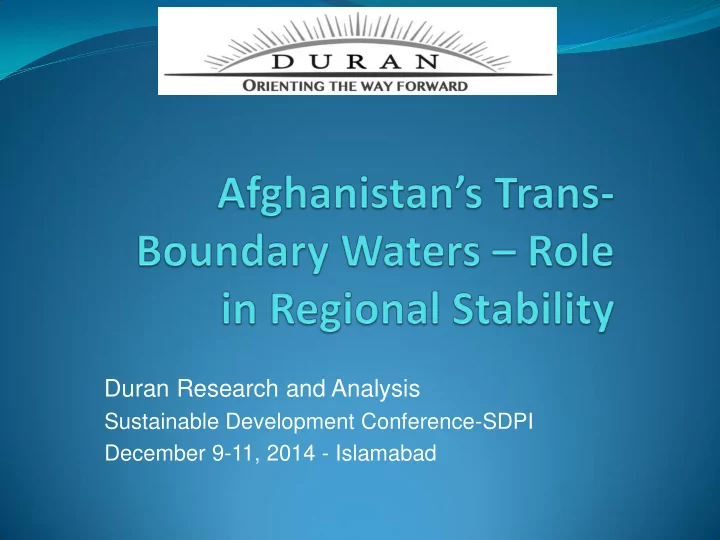

Duran Research and Analysis Sustainable Development Conference-SDPI December 9-11, 2014 - Islamabad
Afghanistan’s River Basins Amu 1. 1800km Boundary with Tajikistan, Uzbekistan & Turkmenistan, Tributaries: Kokcha, Kunduz, Punjab, Khanabad and Aab-i-Rustaq 57% of surface water, Provides for 3 million population, Regulated as per MoU with Former Soviet Union 2. Kabul-Indus Flows to Pakistan Tributaries: Kabul, Panjsher,, Kunar, Gomal, Margo 26% of surface water, provides for 7 million population, no regulation Helmand 3. Flows to Iran, 1973 Treaty! Tributaries: Adraskan, Fara Rod, KhashRod, Khuspas, Kajrod, Band-i- Kajaki, Musa Qala, Arghandab 11% of surface water, provides for 6 million population
Afghanistan’s River Basins Hariroad 1. Flows to Iran, Turkmenistan, No Treaty! Tributaries: Murghab, Kashan-Kushk, Hariroad 4% of surface water, provides for 2million population Northern (not Trans-boundary) 2. Consists of Balkhab, Sherin Tagab, Tashqurghan, Aab-i- Safaid 2% of Surface Water, provides for 3 million population Source: Afghanistan Atlas of Watershed
Afghanistan’s River Basins Amu Kabul Hariroad- Helmand Northern Murghab Water 7,412 2,889 1,777 1,581 676 Availability (m 3) / capita Annual 22 20.76 3.06 9.30 1.88 discharge billion m 3 % of water 24 25 42 58 100 use Mechanism 1958 None None 1973 s Protocol- Treaty: 22 + 4 m 3 / sec Ex-SU – joint to Iran execution of works Source: NDHR
Source: Water availability (m3/capita/year) in five river basins (Favre & Kamal, 2004)
Context – Water Resources Afghanistan’s Water potential is 75,000 million cubic meters. Afghanistan is said to have one of the lowest water retention and utilization capacity, less than 1/3 rd (less than 30%) of its waters due to insufficient infrastructure for water management Climate change is visible in precipitation and temperature regime resulting in prolonged and more frequent droughts and floods. There is a 25-30 years data gap on water resources (1980- 2006…) So all data dates back to 1980 and before.
Water resources potential and using present and future balance 75 80 70 Surface water 57 55 60 Potential (BCM) Groundwater 50 Total 40 35 40 30 30 20 20 17 18 15 15 20 10 10 3 10 0 Potential Present use Balance Future use Balance Source: Water resources (FAO, 1999 and Wincent, 2003)
Regional Context 4 of the 5 river basins are trans-boundary in nature (all except Northern) Afghanistan shares its waters with the Central Asian Republics in the north, Iran in the west and Pakistan in the south/ east Afghanistan has only one water sharing agreement with Iran on the Helmand river basin. There are few indications on water sharing between Afghanistan and Ex-Soviet Union - MoUs Water results in conflict, (2 nd major cause of conflict at community level-NHDR) Provinces close to the rivers suffer from flooding and drought due to poor water management and weak or non-existent water infrastructure
Legal & Policy Context Kabul Understanding - Strategic Framework for the Water Sector Afghanistan Compact Afghanistan National Development Strategy Afghanistan Water Law/ Water Sector Policy National Priority Program: (National Waters and Natural Resource Program, National Energy Supply Program) The National Environmental Law (conservation, protection and improvement of the country’s environment) Afghanistan Drafty Trans-Boundary Policy (under consideration)
Context – Impact of Poor Water Development & Management Under-Developed Economic Infrastructure Agricultural economy (78.6% labor force, 70-80% of GDP, 2.2 million hectares out of 7.9 million hectares cultivated only) Lack of precipitation leads to up to 50% decline in agricultural production (2008) Low National Revenue Generation Capacity Extreme dependence on international community Water can generate enormous revenue Ineffective Legal, Policy and Institutional Context Almost non-existent regional cooperation: The Water Agreement with Iran (Helmand River Basin) is limited to water sharing.
Context – Impact of Poor Water Development & Management Environmentally Hazardous and Unsustainable Development Inadequate water development and lack of attention to its impact on climate change. Alarming Population Growth Expected decrease in water availability by 50% in the next 40 years, in the face of increased population: Afghanistan 65 million, Pakistan 291 million, Iran 100 million by 2050 Potential for Regional Conflict Lack of Sufficient Focus on TBW Development and Management 2005-2006: Iraq $26.5, Afghanistan $3.3 in aid/ capita (NHDR) Water is a sub-sector in practice, Less-Attended!
Policy Recommendations Policy, legal, institutional and infrastructural Reform at national level, prioritizing regional cooperation Build capacity and establish strong knowledge base to address the data gap Move towards regional cooperation, hydro-diplomacy and compliance to international conventions Promote long term and regional sensitive program approach Engage civil society, academia, private sector, media and research organizations extensively (at national and regional level)
Thank you!
Recommend
More recommend